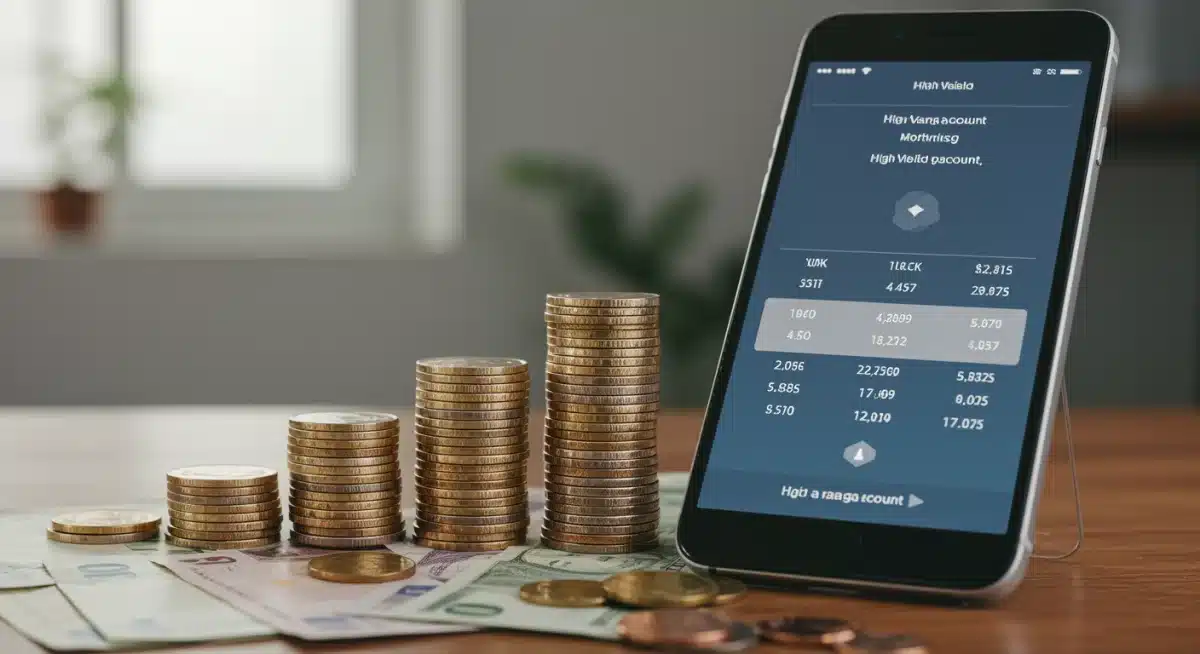Optimize Your Emergency Fund in 2025: High-Yield Savings

Optimizing your emergency fund in 2025 means establishing 3-6 months of essential living expenses within high-yield savings accounts to maximize returns while maintaining liquidity for unforeseen financial challenges.
In an ever-evolving financial landscape, the necessity of a robust emergency fund has never been clearer. This guide will walk you through the essential steps for optimizing your emergency fund in 2025, ensuring you have 3-6 months of living expenses safely stored in high-yield savings accounts.
Understanding the Importance of an Emergency Fund in 2025
An emergency fund acts as your financial safety net, protecting you from unexpected expenses such as job loss, medical emergencies, or unforeseen home repairs. In 2025, with economic uncertainties still prevalent, having a well-structured emergency fund is not just prudent; it’s essential for maintaining peace of mind and preventing debt accumulation.
Many financial experts recommend having at least three to six months’ worth of essential living expenses saved. This figure isn’t arbitrary; it provides a buffer for most common financial disruptions, giving you time to recover without resorting to high-interest credit or liquidating long-term investments. The exact amount will depend on your personal circumstances, including job stability, health, and family size.
Why traditional savings accounts fall short
Traditional savings accounts, while secure, often offer minimal interest rates, barely keeping pace with inflation. This means your money, over time, loses purchasing power. For an emergency fund, which might sit untouched for extended periods, this erosion of value is a significant drawback. It’s crucial to seek out options that offer better returns without sacrificing accessibility.
- Low-interest rates: Most traditional accounts offer less than 0.10% APY.
- Inflation erosion: Your savings lose value over time due to rising costs.
- Missed growth opportunities: Your money isn’t working as hard as it could be.
The goal is to find a balance between security and growth. An emergency fund must be liquid, meaning easily accessible when you need it, but it also benefits from earning a competitive interest rate. This dual requirement often points towards specific financial products designed for such purposes.
Ultimately, understanding the true value of an emergency fund goes beyond just having money set aside. It’s about building resilience and ensuring that unexpected life events don’t derail your entire financial plan. As we move further into 2025, this foundation becomes increasingly critical for long-term financial health.
Calculating Your Emergency Fund Target
Before you can start saving, you need a clear target. Calculating the precise amount you need for your emergency fund involves a detailed assessment of your monthly expenses. This isn’t just about what you spend; it’s about what you absolutely need to survive and maintain your basic lifestyle.
Start by itemizing all your essential monthly expenditures. This includes housing (rent/mortgage), utilities, food, transportation, insurance premiums, and minimum debt payments. Discretionary spending, like dining out or entertainment, should generally be excluded from this calculation, as these are areas you can cut back on during an emergency.
Itemizing essential monthly expenses
A thorough review of your bank statements and credit card bills from the past few months can provide an accurate picture of your spending habits. Categorize each expense into ‘essential’ and ‘non-essential.’ Be honest with yourself; the integrity of your emergency fund depends on a realistic assessment.
- Housing: Rent or mortgage payments, property taxes, homeowner’s insurance.
- Utilities: Electricity, gas, water, internet (essential for many).
- Food: Groceries for home-cooked meals, avoiding restaurant expenses.
- Transportation: Car payments, fuel, public transport costs, car insurance.
- Healthcare: Health insurance premiums, essential prescriptions.
- Minimum Debt Payments: Student loans, credit card minimums (not full payments).
Once you have a solid total for your essential monthly expenses, multiply that figure by three to six, or even twelve, depending on your risk tolerance and job security. For example, if your essential expenses total $3,000 per month, your emergency fund target would be between $9,000 and $18,000.
This calculation provides a concrete goal, transforming the abstract idea of ‘saving for emergencies’ into a manageable financial objective. Regularly reviewing and adjusting this target is also important, as your living expenses and financial situation may change over time.
The Power of High-Yield Savings Accounts (HYSAs)
High-yield savings accounts (HYSAs) are the cornerstone of an optimized emergency fund in 2025. Unlike traditional savings accounts, HYSAs offer significantly higher interest rates, allowing your money to grow faster without exposing it to market volatility. This growth helps to offset inflation, preserving your purchasing power.
HYSAs are typically offered by online banks, which have lower overhead costs compared to brick-and-mortar institutions. These savings are often passed on to customers in the form of elevated annual percentage yields (APYs). The key benefit is that your emergency money remains liquid, meaning you can access it relatively quickly, usually within a few business days.

While the interest rates on HYSAs can fluctuate with the broader economic environment, they consistently outperform traditional savings accounts. This makes them an ideal vehicle for funds that you need to be both safe and somewhat productive.
Key features to look for in a HYSA
When selecting a HYSA, several factors should guide your decision. Beyond the APY, consider the bank’s reputation, any associated fees, and the ease of transferring funds. A good HYSA will strike a balance between competitive rates and user-friendly features.
- Competitive APY: Compare rates across different institutions to find the best return.
- FDIC insurance: Ensure your deposits are insured up to $250,000 per depositor, per bank.
- No monthly fees: Avoid accounts that charge maintenance fees, which can eat into your earnings.
- Easy access to funds: Look for seamless online transfers and optional ATM access.
- Minimum balance requirements: Some HYSAs require a minimum balance to earn the advertised APY.
It’s also beneficial to read customer reviews and understand the bank’s customer service reputation. While online banks offer convenience, you want to be sure you can reach a human if an issue arises, especially when dealing with critical emergency funds. The right HYSA ensures your money is secure, accessible, and actively working for you.
Strategies for Building Your Emergency Fund
Building an emergency fund requires discipline and a strategic approach. It’s not about making one large deposit; it’s about consistent contributions over time. The journey can feel daunting, but breaking it down into smaller, manageable steps makes it achievable.
One of the most effective strategies is to automate your savings. Set up a recurring transfer from your checking account to your HYSA each payday. This removes the temptation to spend the money and ensures consistent progress toward your goal. Even small, regular contributions add up significantly over time.
Tips for accelerating your savings
Beyond automation, several tactics can help you reach your emergency fund target faster. These involve both increasing your income and reducing your expenses, creating more disposable income to direct towards savings.
- Cut discretionary spending: Temporarily reduce non-essential expenses like dining out, entertainment, and subscriptions.
- Increase income: Consider a side hustle, freelance work, or selling unused items to boost your cash flow.
- Windfalls directly to savings: Direct bonuses, tax refunds, or unexpected gifts straight into your emergency fund.
- Budgeting apps: Utilize tools to track spending and identify areas for savings.
- Debt reduction: Prioritize paying off high-interest debt first, freeing up more money for savings.
Another powerful strategy is to adopt a ‘pay yourself first’ mindset. Before you allocate money to bills or other expenses, make sure a portion goes directly into your emergency fund. This prioritizes your financial security and makes saving a non-negotiable part of your financial routine.
Remember that building an emergency fund is a marathon, not a sprint. Celebrate small milestones along the way to stay motivated, and don’t get discouraged by setbacks. Consistency and commitment are your greatest allies in achieving your financial safety net.
Maintaining and Replenishing Your Fund
Building your emergency fund is a significant achievement, but the work doesn’t stop there. Maintaining and, if necessary, replenishing your fund are equally crucial steps to ensure its effectiveness. Life happens, and sometimes you’ll need to tap into those savings. When you do, having a plan to rebuild is essential.
Regularly review your emergency fund balance to ensure it still aligns with your current living expenses. As your income or expenses change, your emergency fund target might also need adjustment. For example, a new family member or a significant increase in housing costs would warrant a higher fund.
When to use your emergency fund
It’s vital to distinguish between a true emergency and a non-essential expense. Your emergency fund is not for impulse purchases or vacations. It’s specifically for unforeseen events that would otherwise put you in financial distress.
- Job loss: Covering living expenses while you seek new employment.
- Medical emergencies: Unexpected healthcare costs not fully covered by insurance.
- Major home repairs: A burst pipe, furnace breakdown, or roof damage.
- Car repairs: Essential repairs that prevent you from commuting to work.
- Unforeseen travel: Urgent family matters requiring immediate travel.
If you find yourself needing to use your emergency fund, don’t feel guilty. That’s precisely what it’s for. However, once the immediate crisis has passed, make it a top priority to replenish the funds you’ve used. Treat it with the same urgency as paying a critical bill.
Establishing an automatic transfer plan to rebuild your fund, even if it’s a smaller amount initially, can help you get back on track. The goal is to restore your financial safety net as quickly as possible, ensuring you’re prepared for any future unexpected events. Consistent vigilance and proactive planning are key to long-term financial security.
Beyond the Emergency Fund: Next Steps in Financial Planning
Once you’ve successfully built and optimized your emergency fund, you’ve established a strong foundation for your financial future. This achievement opens the door to pursuing other important financial goals. It’s a testament to your discipline and commitment, and now you can leverage that momentum.
With your emergency fund secured, you can confidently shift your focus to long-term investments, retirement planning, and other wealth-building strategies. The peace of mind that comes with a robust safety net allows you to take calculated risks with your investments, knowing you have a buffer against market fluctuations.
Investing for the future
Your emergency fund should remain in a liquid, low-risk account like a HYSA. However, any savings beyond that can be directed towards investments with potentially higher returns, albeit with greater risk. This is where a diversified portfolio comes into play.
- Retirement accounts: Maximize contributions to 401(k)s, IRAs, or Roth IRAs for tax-advantaged growth.
- Investment accounts: Consider brokerage accounts for stocks, bonds, mutual funds, or ETFs.
- Education savings: If applicable, contribute to 529 plans for future educational expenses.
- Debt repayment: Accelerate payments on high-interest debts like credit cards or personal loans.
- Long-term goals: Save for a down payment on a home, a new car, or other significant life purchases.
Consulting with a financial advisor can be beneficial at this stage. They can help you create a personalized financial plan that aligns with your risk tolerance, time horizon, and specific goals. They can also provide insights into tax-efficient investment strategies and help you navigate complex financial products.
Remember, financial planning is an ongoing process. Regularly review your goals, adjust your strategies as needed, and stay informed about economic changes. Building an emergency fund is just the beginning of a lifelong journey towards financial independence and security.
| Key Point | Brief Description |
|---|---|
| Emergency Fund Goal | Aim for 3-6 months of essential living expenses, tailored to your personal situation and risk tolerance. |
| High-Yield Savings Accounts (HYSAs) | Utilize HYSAs for higher interest rates than traditional accounts, ensuring liquidity and growth for your emergency funds. |
| Building Strategies | Automate savings, cut discretionary spending, and direct windfalls to accelerate fund growth. |
| Maintenance & Replenishment | Regularly review your fund, use it only for true emergencies, and prioritize rebuilding it quickly after use. |
Frequently Asked Questions About Emergency Funds
Financial experts generally recommend saving 3 to 6 months’ worth of essential living expenses. However, some individuals, especially those with variable income or high-risk jobs, might prefer 9 to 12 months for added security in 2025.
High-yield savings accounts offer significantly better interest rates than traditional savings, allowing your emergency fund to grow and keep pace with inflation. They also maintain liquidity, ensuring your money is accessible when true emergencies arise, without market risk.
To calculate, review your bank statements and bills for the past few months. List all non-negotiable expenses like housing, utilities, food, transportation, insurance, and minimum debt payments. Exclude discretionary spending like entertainment or dining out.
No, it’s generally not advisable. An emergency fund needs to be stable and easily accessible, without exposure to market volatility. High-yield savings accounts provide security and liquidity, making them far more suitable for these critical funds than stock market investments.
If you use your emergency fund for a legitimate crisis, prioritize replenishing it as quickly as possible. Treat it like a crucial bill; set up automatic transfers to rebuild the amount, ensuring your financial safety net is restored for future unforeseen events.
Conclusion
Optimizing your emergency fund in 2025 is a critical step towards achieving lasting financial security and peace of mind. By diligently calculating your essential expenses, strategically utilizing high-yield savings accounts, and committing to consistent contributions, you build a robust financial safety net. This foundation not only protects you from unexpected life events but also empowers you to pursue broader financial goals with confidence. Remember, an emergency fund is more than just savings; it’s an investment in your future stability and well-being.





